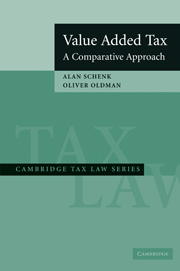Book contents
- Frontmatter
- Contents
- List of Tables, Figures, and Charts
- List of Cases
- Preface to the Revised Edition
- Value Added Tax
- 1 SURVEY OF TAXES ON CONSUMPTION AND INCOME, AND INTRODUCTION TO VALUE ADDED TAX
- 2 FORMS OF CONSUMPTION-BASED TAXES AND ALTERING THE TAX BASE
- 3 VARIETIES OF VAT IN USE
- 4 REGISTRATION, TAXPAYER, AND TAXABLE BUSINESS ACTIVITY
- 5 TAXABLE SUPPLIES OF GOODS AND SERVICES, AND TAX INVOICES
- 6 THE TAX CREDIT MECHANISM
- 7 INTRODUCTION TO CROSS-BORDER ASPECTS OF VAT
- 8 TIMING, TRANSITION AND VALUATION RULES
- 9 ZERO RATING AND EXEMPTIONS AND GOVERNMENT ENTITIES AND NONPROFIT ORGANIZATIONS
- 10 GAMBLING AND FINANCIAL SERVICES (OTHER THAN INSURANCE)
- 11 INSURANCE
- 12 INTERJURISDICTIONAL ASPECTS OF VAT IN FEDERAL COUNTRIES AND COMMON MARKETS
- 13 REAL PROPERTY
- 14 PROPOSALS FOR U.S. TAX ON CONSUMPTION
- APPENDIXES
- Index
13 - REAL PROPERTY
Published online by Cambridge University Press: 06 January 2010
- Frontmatter
- Contents
- List of Tables, Figures, and Charts
- List of Cases
- Preface to the Revised Edition
- Value Added Tax
- 1 SURVEY OF TAXES ON CONSUMPTION AND INCOME, AND INTRODUCTION TO VALUE ADDED TAX
- 2 FORMS OF CONSUMPTION-BASED TAXES AND ALTERING THE TAX BASE
- 3 VARIETIES OF VAT IN USE
- 4 REGISTRATION, TAXPAYER, AND TAXABLE BUSINESS ACTIVITY
- 5 TAXABLE SUPPLIES OF GOODS AND SERVICES, AND TAX INVOICES
- 6 THE TAX CREDIT MECHANISM
- 7 INTRODUCTION TO CROSS-BORDER ASPECTS OF VAT
- 8 TIMING, TRANSITION AND VALUATION RULES
- 9 ZERO RATING AND EXEMPTIONS AND GOVERNMENT ENTITIES AND NONPROFIT ORGANIZATIONS
- 10 GAMBLING AND FINANCIAL SERVICES (OTHER THAN INSURANCE)
- 11 INSURANCE
- 12 INTERJURISDICTIONAL ASPECTS OF VAT IN FEDERAL COUNTRIES AND COMMON MARKETS
- 13 REAL PROPERTY
- 14 PROPOSALS FOR U.S. TAX ON CONSUMPTION
- APPENDIXES
- Index
Summary
INTRODUCTION
One of the most complicated problems in designing a VAT base involves the taxation of real (immovable) property. The tax base should consist of the personal consumption element in real property (for residential property, living quarters either owned or leased). In the United States, housing represents over 16 percent of total personal consumption expenditures. The difficulty is to identify the personal consumption element, especially for real property that may be used for business or personal purposes.
There are a number of possible techniques for taxing real property under a VAT. They must consider valuation and other administrative issues in the context of business versus personal, investment versus consumption.
ARRAY OF VAT TREATMENT OF REAL (OR IMMOVABLE) PROPERTY
A variety of approaches to the taxation of real property are available, even if they are based on the principles that a VAT is a tax on personal consumption, and the tax should not be imposed on the same value added to goods or services more than once.
Real property is a long-lived asset, even more so than other consumer durables. Ideally, the current use of consumer durables should be taxed each year. This approach raises significant administrative and practical problems. As a result, most consumer durables are taxed at the time of purchase (based on the consideration paid). This approach reflects a decision to tax the present discounted value of the stream of future personal consumption. The same approach could be used for real property.
- Type
- Chapter
- Information
- Value Added TaxA Comparative Approach, pp. 408 - 432Publisher: Cambridge University PressPrint publication year: 2007



